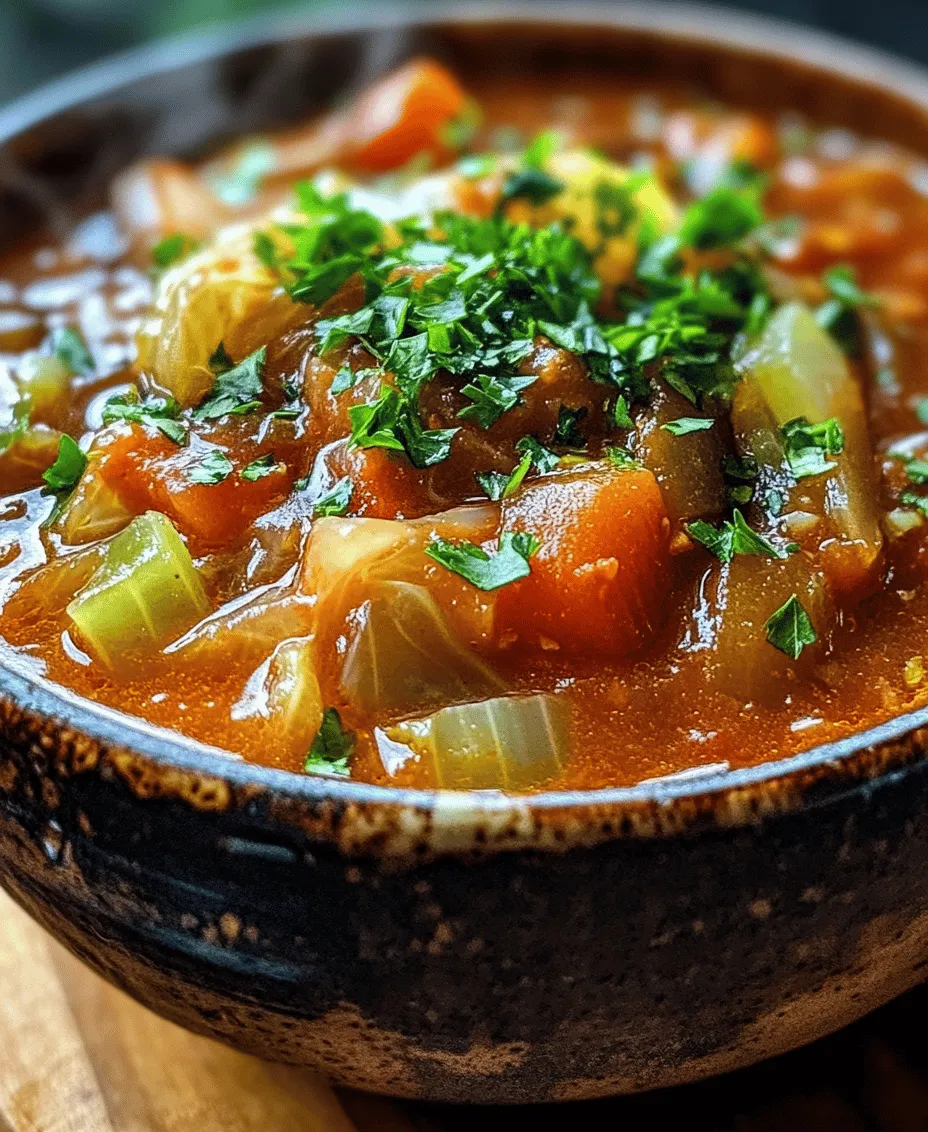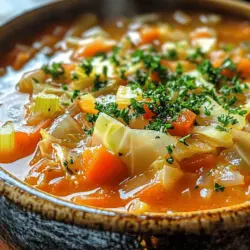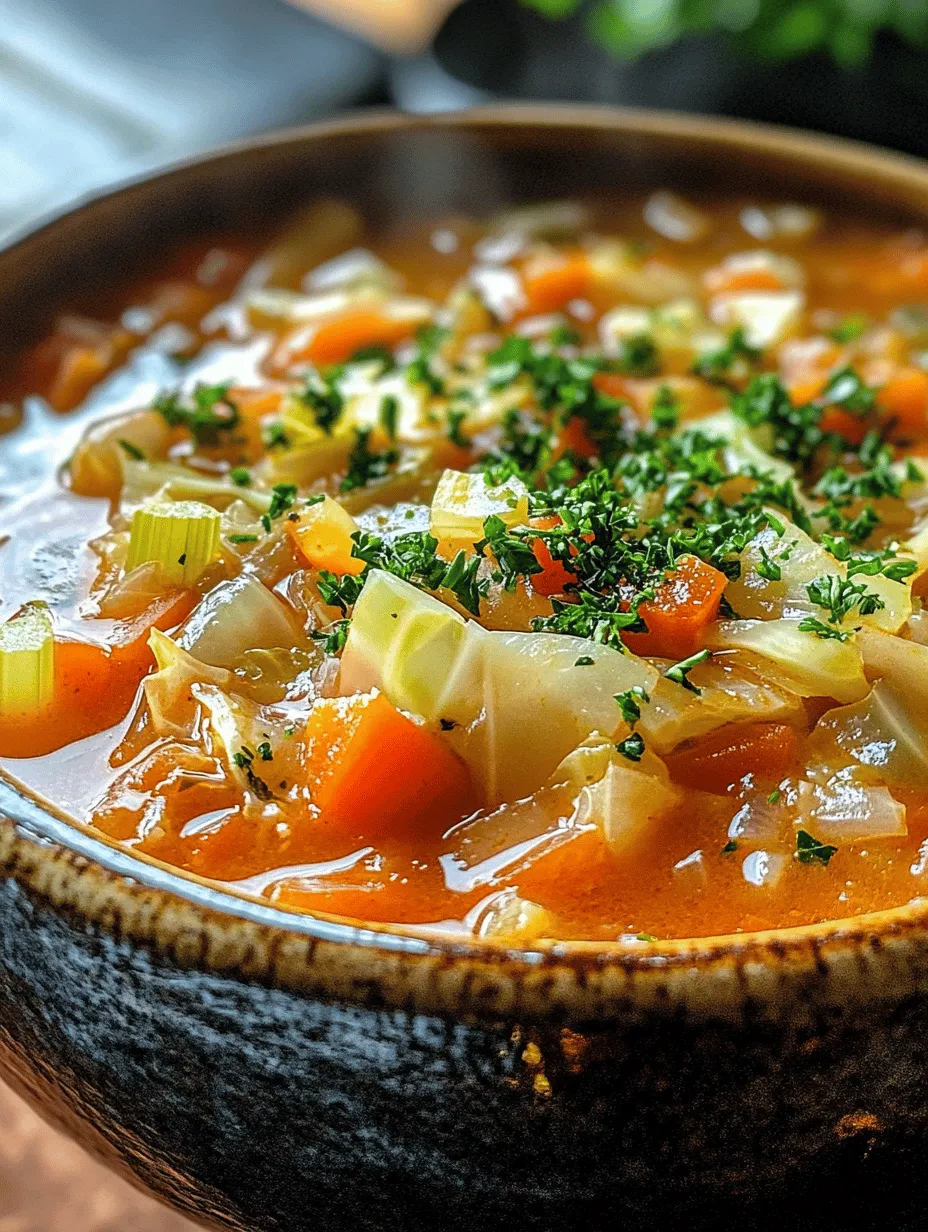Introduction to Comforting Cabbage Soup
Cabbage soup is more than just a dish—it’s a beloved comfort food that has warmed hearts and bellies for generations. Often associated with home-cooked meals and family gatherings, this nourishing soup brings a sense of nostalgia with every spoonful. The simplicity of cabbage soup lies in its ability to blend wholesome ingredients into a hearty bowl that feels both satisfying and revitalizing. Whether you’re enjoying it on a chilly winter evening or as a light meal during the warmer months, cabbage soup is a versatile dish that transcends seasons.
One of the standout features of cabbage soup is its health benefits. Cabbage, the star ingredient, is low in calories yet rich in essential nutrients. This cruciferous vegetable is packed with vitamins C, K, and B6, as well as fiber, which promotes digestive health. Combined with a variety of colorful vegetables, each contributing its own unique flavor and nutritional profile, cabbage soup becomes a powerhouse of wellness. The array of ingredients not only enhances the taste but also ensures that each bowl is brimming with vitamins and minerals.
In addition to its health benefits, the simplicity of homemade cabbage soup makes it truly special. With minimal prep time and straightforward cooking steps, anyone can whip up a pot of this delicious soup. The process of simmering the vegetables together allows the flavors to meld beautifully, creating a warm and comforting dish that is perfect for any occasion. Whether you’re looking for a quick weeknight meal or a dish to share with friends, cabbage soup is an excellent choice that embodies the essence of homemade comfort.
The Ingredients: A Closer Look at Each Component
To create a truly comforting cabbage soup, we need to focus on the quality and freshness of our ingredients. Each component plays a crucial role in building the flavor and texture of the soup. Let’s take a closer look at the key ingredients that make this dish shine.
Cabbage: The Star of the Show
At the heart of our cabbage soup is, of course, cabbage. This leafy green vegetable is not only delicious but also incredibly nutritious. Cabbage is an excellent source of vitamins K and C, both of which are vital for maintaining healthy bones and a strong immune system. Additionally, it contains fiber, which aids in digestion and helps you feel full longer.
There are several types of cabbage available, each with its unique flavor and texture. Green cabbage is the most common variety used in soups, but red cabbage and Savoy cabbage can also be excellent choices. Red cabbage adds a touch of sweetness and a vibrant color to your soup, while Savoy cabbage offers a tender leaf with a slightly milder flavor. Feel free to mix and match these varieties based on your preference or what you have on hand—cabbage is incredibly versatile!
Vegetables: Building Flavor and Texture
While cabbage takes center stage, the supporting cast of vegetables adds depth and complexity to the soup. Fresh vegetables such as onions, garlic, carrots, celery, and red bell peppers are essential for creating a well-rounded flavor profile.
– Onions: A staple in many savory dishes, onions provide a sweet and aromatic base for the soup when sautéed. Their natural sugars caramelize during cooking, adding richness to the overall flavor.
– Garlic: Known for its bold flavor, garlic brings a savory punch to the dish. It also boasts numerous health benefits, including anti-inflammatory properties and immune support.
– Carrots: These vibrant orange vegetables add sweetness and color to the soup. Rich in beta-carotene, carrots contribute to healthy vision and skin.
– Celery: Celery not only adds a satisfying crunch but also enhances the overall flavor with its mild, slightly peppery taste. It’s a great source of vitamins K and C, as well as potassium.
– Red Bell Peppers: Sweet and juicy, red bell peppers infuse the soup with a pop of color and flavor. They’re high in vitamin A and C, making them a nutritious addition.
Using fresh vegetables ensures that your cabbage soup is bursting with flavor and nutrients. The combination of these colorful ingredients creates a visually appealing dish that is as enjoyable to eat as it is to look at.
Tomatoes and Broth: The Flavor Base
To elevate the flavor of your cabbage soup, we turn to canned diced tomatoes and broth. The addition of tomatoes not only enhances the taste but also contributes acidity, which helps balance the sweetness of the vegetables. Canned diced tomatoes are convenient and packed with flavor, making them a go-to choice for soups and stews.
When it comes to broth, you have options. Vegetable broth is an excellent choice for a vegetarian or vegan version of cabbage soup, while chicken broth adds a rich, savory depth to the dish. Choosing the right broth can significantly impact the overall taste of your soup, so opt for high-quality, low-sodium varieties to control the saltiness and flavor intensity.
Herbs and Seasonings: Elevating the Dish
No soup is complete without the right herbs and seasonings, which can transform a simple dish into a gourmet experience. For our comforting cabbage soup, dried thyme, oregano, and bay leaf are essential.
– Dried Thyme: This aromatic herb adds an earthy flavor that complements the vegetables beautifully. Thyme is also known for its antioxidant properties, making it a healthy addition to your soup.
– Oregano: With its robust flavor, oregano brings a warm, slightly bitter note to the dish. It’s a classic herb used in many Mediterranean recipes and works wonderfully in soups.
– Bay Leaf: Adding a bay leaf during cooking infuses the soup with a subtle depth of flavor. Just remember to remove it before serving, as it can be tough and inedible.
Seasoning your soup appropriately is key to unlocking its full flavor potential. Taste as you go and adjust the seasoning to suit your preferences. A pinch of salt and pepper can go a long way in enhancing the overall taste.
Optional Ingredients: Customizing Your Soup
One of the joys of making cabbage soup is its adaptability. While the base recipe is comforting and delicious, you can easily customize it to suit your taste preferences. For instance, a splash of lemon juice can brighten the flavors and add a refreshing zing to the soup. This touch of acidity enhances the overall balance of flavors and can elevate the dish to new heights.
Additionally, consider incorporating optional ingredients to add protein or unique flavors. For a heartier version, you can add canned beans, such as white beans or chickpeas, which not only boost the nutrition but also make the soup more filling. If you’re looking for a meatier option, shredded chicken can be a great addition, providing a savory element that complements the vegetables.
Preparation Steps: Crafting Your Comforting Cabbage Soup
Now that we’ve explored the essential ingredients, it’s time to dive into the preparation process. Making cabbage soup is straightforward, and the following steps will guide you through crafting this comforting dish:
1. Sautéing the Aromatics: Begin by heating a drizzle of olive oil in a large pot over medium heat. Once the oil is hot, add the chopped onions and sauté until they become translucent, about 5 minutes. Next, add minced garlic and sauté for an additional minute, allowing the garlic to release its fragrant aroma.
2. Add the Vegetables: Incorporate the chopped carrots, celery, and red bell peppers into the pot. Stir the mixture and cook for about 5-7 minutes, or until the vegetables are slightly softened. This step helps build a flavorful foundation for your soup.
With the aromatics and vegetables sautéed, you’re well on your way to creating a delicious batch of comforting cabbage soup. The next steps will involve adding the cabbage, tomatoes, broth, and seasonings, bringing everything together for a warm and satisfying meal. Stay tuned for the continuation of this recipe, where we’ll explore the final steps to crafting the perfect bowl of soup!

Importance of Sautéing Onions and Garlic to Build the Foundation of Flavor
Sautéing onions and garlic is a fundamental step in creating a rich and satisfying flavor base for your cabbage soup. When you begin by sautéing these aromatics in a bit of olive oil or butter, you unlock their natural sweetness and create a fragrant foundation that will enhance the overall taste of your dish. The process of cooking onions until they turn translucent and slightly caramelized allows their sugars to develop, adding depth to the soup. Garlic, added a minute or two later, contributes its pungent aroma and flavor, creating a harmonious blend that will permeate the entire pot as the soup simmers.
To achieve the perfect sauté, heat your oil in a large pot over medium heat. Add chopped onions and a pinch of salt, stirring frequently until they soften, which usually takes about 5-7 minutes. Next, add in minced garlic and continue to sauté for another minute. Be careful not to let the garlic burn, as it can turn bitter. This step not only lays the groundwork for the cabbage soup but also builds anticipation for the flavors to come.
Layering the Vegetables
The way you layer vegetables in your soup can greatly influence its texture and taste. Start by adding heartier vegetables that take longer to cook, such as carrots and celery, right after you’ve sautéed the onions and garlic. This allows them to soften and become tender in the broth. Chop these vegetables into uniform pieces to ensure even cooking.
Next, introduce the star of the show, cabbage, which should be sliced thinly to help it cook quickly and evenly. Adding the cabbage at this stage allows it to wilt and integrate with the other vegetables, enhancing the soup’s overall flavor. If your recipe includes other vegetables, such as bell peppers or zucchini, add them according to their cooking times—softer vegetables can be added a bit later.
Finally, finish layering with any delicate ingredients like spinach or herbs just before serving. This way, they retain their vibrant colors and nutrients, adding a fresh element to your comforting cabbage soup.
Simmering: The Key to Developing Flavor
Simmering is a crucial technique for developing the deep, comforting flavors in your cabbage soup. Once you have added your broth, bring the mixture to a boil, then reduce the heat to allow it to simmer gently. This slow cooking process encourages the ingredients to release their flavors into the broth, creating a rich and cohesive taste.
A good rule of thumb is to let your soup simmer for at least 30 minutes. This allows the cabbage and other vegetables to become tender while the flavors meld together beautifully. For an even more profound taste, consider simmering your soup for an hour or more. The longer the soup cooks, the more the flavors will develop, creating a comforting and aromatic dish that warms both body and soul.
Adjusting Seasonings: Getting It Just Right
One of the most important steps in crafting a delicious cabbage soup is to taste and adjust the seasonings to suit your personal preference. After the soup has simmered for a while, take a moment to taste it. This is your opportunity to decide if it needs a little more salt, pepper, or perhaps a dash of acidity from lemon juice or vinegar to brighten the flavors.
Remember that you can also tailor the seasoning to match your taste buds. For a bit of heat, consider adding red pepper flakes or a splash of hot sauce. If you prefer an herby flavor, fresh or dried thyme, oregano, or parsley can elevate the dish. The key is to build the flavor progressively—add seasonings gradually, tasting as you go, until you achieve a well-balanced soup that delights your palate.
Nutritional Benefits of Cabbage Soup
Cabbage soup is not only delicious but also packed with numerous health benefits. Let’s examine some of the standout advantages of this comforting dish.
Low-Calorie Comfort Food
One of the most appealing aspects of cabbage soup is its low-calorie content, making it an excellent choice for those looking to manage their weight. With its primarily vegetable-based ingredients, cabbage soup is filling without adding excessive calories. This means you can enjoy a hearty serving without guilt, perfect for those following a weight-loss diet or anyone looking to maintain a balanced lifestyle.
Rich in Vitamins and Minerals
Cabbage, the star ingredient in this soup, is rich in essential vitamins and minerals. It is particularly high in vitamin C, which supports the immune system and enhances skin health. Additionally, cabbage provides vitamin K, which is crucial for bone health and proper blood clotting. The other vegetables in the soup, such as carrots and bell peppers, contribute even more vitamins, including A and B vitamins, making this soup a nutrient-dense option that supports overall wellness.
High in Fiber
Fiber is an essential component of a healthy diet, aiding in digestion and helping to maintain a healthy weight. Cabbage soup is high in dietary fiber, thanks to its vegetable content. Fiber promotes feelings of fullness, which can help curb overeating and assist in weight management. Moreover, it supports digestive health by preventing constipation and promoting regular bowel movements.
Serving Suggestions: Enjoying Your Cabbage Soup
Serving cabbage soup can be a delightful experience that enhances the meal. Here are some ideas to elevate your soup presentation and enjoyment.
Accompaniments
Pair your cabbage soup with crusty bread or warm rolls for a satisfying meal. A slice of sourdough or whole-grain bread can be perfect for dipping into the soup, soaking up the delicious broth. Alternatively, consider serving the soup alongside a light salad to add freshness and crunch, such as a simple mixed greens salad with a vinaigrette dressing. Crackers can also make for a great accompaniment, offering a nice contrast in texture.
Storage and Reheating
Cabbage soup is an excellent dish for meal prep, as it stores well and tastes even better the next day. To store your leftovers, let the soup cool completely before transferring it to an airtight container. It can be kept in the refrigerator for up to 5 days or frozen for up to 3 months. When reheating, you can warm it gently on the stovetop over medium heat, stirring occasionally. If the soup has thickened in the fridge, don’t hesitate to add a splash of water or broth to achieve your desired consistency.
Conclusion: Embracing the Comfort of Homemade Soup
Homemade cabbage soup is a celebration of comfort food at its finest. With its heartwarming flavors and nutritious ingredients, this soup is a staple that deserves a place in every kitchen. It embodies the essence of home cooking, bringing families together and providing nourishment that warms both body and spirit.
As you embark on your cabbage soup journey, don’t hesitate to experiment with different ingredients and flavors. Incorporate your favorite vegetables, herbs, or proteins to make the recipe your own. The joy of cooking lies in the ability to adapt and create dishes that reflect your taste preferences.
Finally, remember the joy that comes from sharing homemade meals with family and friends. A pot of cabbage soup is not just a dish; it’s an invitation to gather around the table, share stories, and create memories. So, embrace the comforting qualities of homemade soup, and enjoy each spoonful as a reminder of the warmth and love that can be found in every bowl.

